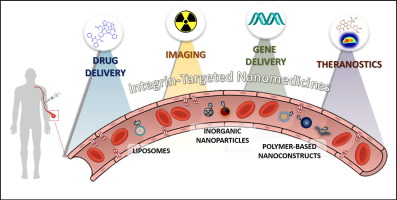Advanced Drug Delivery Reviews ( IF 15.2 ) Pub Date : 2017-05-12 , DOI: 10.1016/j.addr.2017.05.008 Aroa Duro-Castano , Elena Gallon , Caitlin Decker , María J. Vicent

|
Targeting angiogenesis-related pathologies, which include tumorigenesis and metastatic processes, has become an attractive strategy for the development of efficient guided nanomedicines. In this respect, integrins are cell-adhesion molecules involved in angiogenesis signaling pathways and are overexpressed in many angiogenic processes. Therefore, they represent specific biomarkers not only to monitor disease progression but also to rationally design targeted nanomedicines. Arginine-glycine-aspartic (RGD) containing peptides that bind to specific integrins have been widely utilized to provide ligand-mediated targeting capabilities to small molecules, peptides, proteins, and antibodies, as well as to drug/imaging agent-containing nanomedicines, with the final aim of maximizing their therapeutic index. Within this review, we aim to cover recent and relevant examples of different integrin-assisted nanosystems including polymeric nanoconstructs, liposomes, and inorganic nanoparticles applied in drug/gene therapy as well as imaging and theranostics. We will also critically address the overall benefits of integrin-targeting.
中文翻译:

用整合素靶向的纳米药物调节血管生成
靶向血管生成相关的病理学,包括肿瘤发生和转移过程,已成为开发高效引导纳米药物的有吸引力的策略。在这方面,整联蛋白是参与血管生成信号通路的细胞粘附分子,并在许多血管生成过程中过表达。因此,它们代表了特定的生物标志物,不仅可以监测疾病的进展,而且可以合理地设计目标纳米药物。与特定整合素结合的含精氨酸-甘氨酸-天冬氨酸(RGD)的肽已被广泛用于为小分子,肽,蛋白质和抗体以及含药物/显像剂的纳米药物提供配体介导的靶向能力。最大化其治疗指数的最终目的。在此评论中,我们旨在涵盖不同整合素辅助纳米系统的最新和相关实例,包括用于药物/基因治疗以及成像和治疗学的聚合物纳米结构,脂质体和无机纳米颗粒。我们还将严格解决整联蛋白靶向的整体优势。











































 京公网安备 11010802027423号
京公网安备 11010802027423号